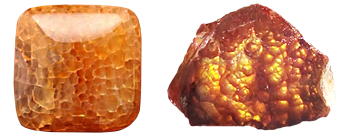 Photo of Fire Agate in Processed & Rough Form
Photo of Fire Agate in Processed & Rough Form
Fire Agate is a mineral with a hardness of 7 out of 10 on the Mohs scale of mineral hardness [?]. These Trigonally structured gems are made of silicon dioxide, their full chemical compound being SiO2.
Fire Agate is a term applied to much of the variety of chalcedony that occurs as botryoidal, consisting of crystals of minute platy inclusion of an iron mineral goethite or limonite minerals over the layers of chalcedony, producing a vivid rainbow containing every color in the spectrum, an iridescent, fire-like appearance, with careful polishing away of the brown outside layers. When polished, it looks like opal, and is hard enough to resist fading, cracking and scratching.
This iridescence is created by the Schiller effect as found in mother-of-pearl, caused by the alternating silica and iron oxide layers which diffract and allow light to pass and form interference of colors known as fire. This effect arises from light interference within the microstructure layering of the gem, and not from any actual object inside the stone.
It is found in California and Arizona (USA), and certain parts of Northern Mexico.
Agates are found as nodules or geodes in siliceous volcanic rocks (melaphyre, porphyry) with sizes varying from a fraction of an inch to a circumference of several yards. The bands are formed by rhythmic crystallization, but scientific opinions vary as to how.
"Fire agate" is also used as a misleading term for a type of glass.
The specific gravity [?] for Fire Agate is 2.61, it's refractive index [?] is 1.53-1.54, and it's double refraction [?] is 0.004.
History
The name agate is derived from the sicilian river Achates where agates were probably found in antiquity. Its distinction as "fire agate" describes its appearance as very much like looking at fire.
Fire agates were probably formed during massive volcanic activity of the Tertiary Period, this time of volcanism when hot water, saturated with silica and iron oxide, repeatedly filled cracks and bubbles in the surrounding rock.
Industrial Usages
When cut and polished carefully as a cabochon only a very thin layer of chalcedony covers the inclusions. This material has been set in jewelry.









